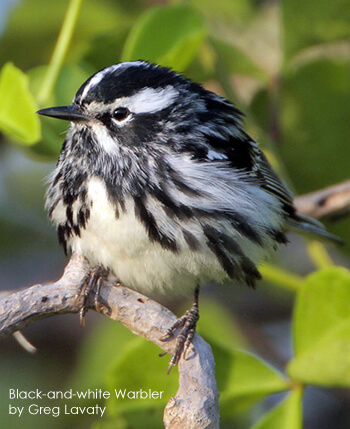Fall Brings Sudden and Violent Death for Millions of Migrating Birds
 |
|---|
(Washington, D.C., September 12, 2013) Fall means lots of different things to different people. To some, it means a kaleidoscope of beautiful fall colors as trees turn. To others, it means the start of another school year. But for millions of birds, fall brings a long migration that often ends in a sudden and violent death as they collide with glass surfaces used in the construction of both houses and office buildings.
“Without question, it is one of the most significant causes of bird mortality worldwide and one that is probably escalating every year,” says Dr. Christine Sheppard, Birds Collisions Campaign Manager for American Bird Conservancy (ABC) and one of the world's leading experts on the issue.
Sheppard says that between 300 million and one billion birds die each year from collisions with glass in the United States. Some of the species that seem to be most affected are the Wood Thrush, Common Yellowthroat, Black-and-white Warbler, Dark-eyed Junco, White-throated Sparrow, Ruby-throated Hummingbird, and American Woodcock. The highest toll is in the fall and spring migration seasons, when birds are travelling great distances through unfamiliar territory. What makes matters worse, Sheppard says, is that nighttime lighting in cities actually attracts birds to dangerous urban environments.
“Parts of this problem are very simple to understand. For example, cues like window frames and even dirt tell people where to expect glass. Birds don't learn these cues and so they take reflections literally or try to fly through transparent glass to reach something beyond it,” according to Sheppard.
Unlike people, birds can see some ultraviolet light, the kind we call UVA. “It seems possible that glass or window film could be developed with signals only birds could see,” says Sheppard. “Several companies have such products or are developing them, although it is technically challenging.”
Sheppard is hard at work evaluating existing materials and prototypes, rating solutions for architects, developers, and designers—as well as individuals with windows at home or at the office. Right now and during every spring and fall, Sheppard and her technicians conduct real-time bird collision avoidance testing at the Carnegie Museum's Powdermill Avian Research Center, near Pittsburgh, Pa. ABC, the only bird conservation group to carry out a national bird collision program, operates the testing facility.
“Manufacturers are becoming interested as they see a growing demand for bird-friendly glass. There are already highly effective products that cover less than 10 percent of the glass surface—but they are not invisible to people, which is a problem for some design situations. One commercially available product with a UV signal is virtually transparent, but only moderately effective. However, this manufacturer and others are working hard to perfect the technology,” she says.
Progress in Preventing Bird Collisions
While progress identifying and producing bird-friendly glass is slowly advancing, there are also reasons for optimism. The state of Minnesota and the city of Oakland, Calif., are the latest in a string of governments to approve bird-friendly building design requirements. Oakland has adopted requirements similar to those established in neighboring San Francisco in 2011, while Minnesota followed the framework in LEED's (Leadership in Engineering and Environmental Design) pilot credit for “Reducing Bird Collisions.” In Illinois, several jurisdictions—Cook County, Highland Park, Lake County, and Evansville—have existing or pending guidelines, and California's Green Building Standards Code encourages voluntary application of bird-friendly design practices. Meanwhile, national legislation to reduce bird collisions in federal buildings has been proposed in the U.S. Congress.
“We are seeing increasing interest in and awareness of this issue among governments, architects, and developers,” says Sheppard. As evidence, bird collisions was featured on the cover of the current edition of the journal Science News (September 21, 2013).
Sheppard worked extensively with officials in San Francisco, along with Noreen Weedon from Golden Gate Audubon, to develop that city's bird-friendly requirements. She also has been presenting continuing education classes on the issue to architecture firms across the country upon request, and authored the only national publication on the issue: American Bird Conservancy's Bird-Friendly Building Design.
Tips to Reduce Bird Collisions
General guidelines: Most birds will avoid windows with vertical stripes spaced four inches apart, or horizontal stripes spaced two inches apart. More complicated or irregular patterns will also work as long as they follow those general guidelines. For best results, patterns must be on the outside surface of the windows.
- Apply tempera paint (available at most art and craft stores) freehand with brush or sponge, or use a stencil. Tempera is nontoxic and long lasting, even in rain, but comes right off with a damp rag or sponge. Find stencils at craft stores or download free stencils online. Make seasonal designs a family project.
- Use tape to create patterns. Any opaque tape can work, but translucent ABC BirdTape transmits light and is made to last outdoors.
- Most window films designed for external use are not patterned and will not deter birds. However, interior window films come in many colors and styles, and can be applied on the outside of windows to prevent collisions.
- If you don't want to alter the glass itself, you can stretch lightweight netting, screen, or other material over the window. The netting must be several inches in front of the window, so birds don't hit the glass after hitting the net. Several companies sell screens, solar shades, or other barriers that can be attached with suction cups or eye hooks.
- Prefabricated decals can work if spaced properly. The shape does not matter; birds see decals shaped like raptors as obstacles but not as predators. To be effective, decals must be spaced no more than four inches apart horizontally or two inches apart vertically—more closely than recommended by most manufacturers.


















































